
| Painted Apple Moth (PAM) (one synonym: Orgyia phineus Herrich-Schäffer, [1858]) LYMANTRIINAE, EREBIDAE, NOCTUOIDEA | (donherbisonevans@yahoo.com) and Stella Crossley |
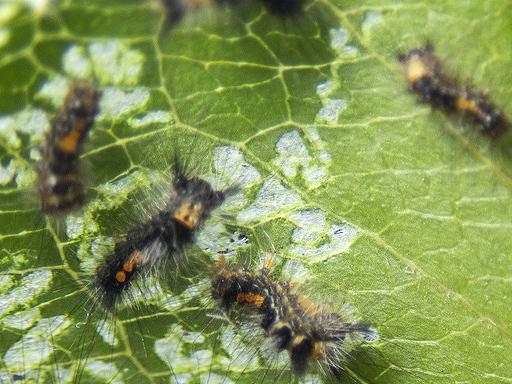
early instars
(Photo: courtesy of
David Akers,
Won Wron, Victoria)

| Painted Apple Moth (PAM) (one synonym: Orgyia phineus Herrich-Schäffer, [1858]) LYMANTRIINAE, EREBIDAE, NOCTUOIDEA | (donherbisonevans@yahoo.com) and Stella Crossley |

early instars
(Photo: courtesy of
David Akers,
Won Wron, Victoria)
Ealy instars of this Caterpillar are usually dark brown and hairy, with a pair of hair pencils sticking out diagonally from each side of its head, and two yellow patches on the back. The young caterpillars eat the flesh only from one side of the leaf they are feeding on.

Later instars nibble from the edges of leaves, eating whole leaves. The body colour of later instars can vary from yellow to black, with several broken white lines running along the body.
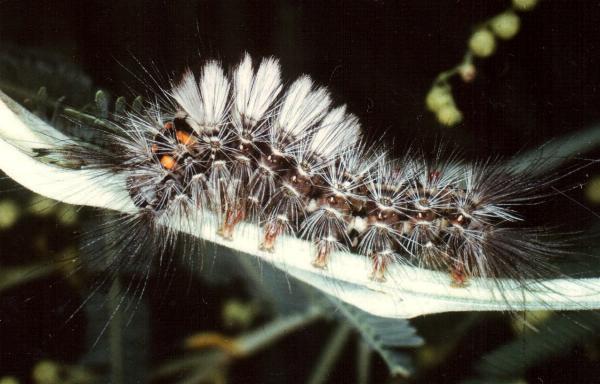
The caterpillar has four tufts of hair on the backs of the first four abdominal segments. The colours of these four dorsal tufts vary from white through yellow or brown to black.

There is also also a hair tuft on its tail, and also two black-tipped tufts on its head pointing diagonally left and right like a pair of horns.
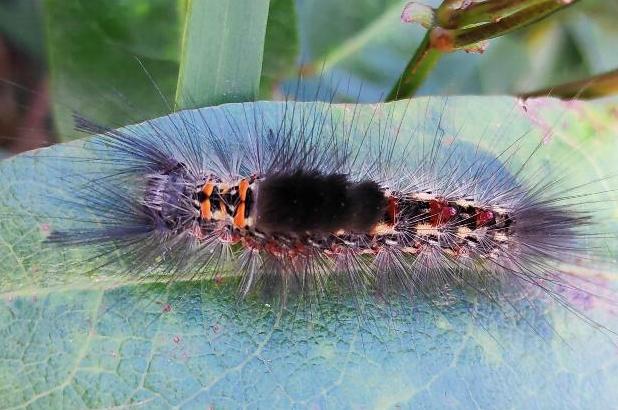
The colour of the head varies from pale brown to black. The thorax has two or four orange marks. There is an enigmatic dorsal yellow or red gland on each of the two or three penultimate abdominal segments, the function of which is unclear.
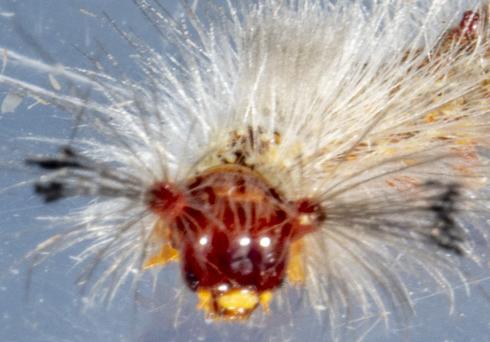
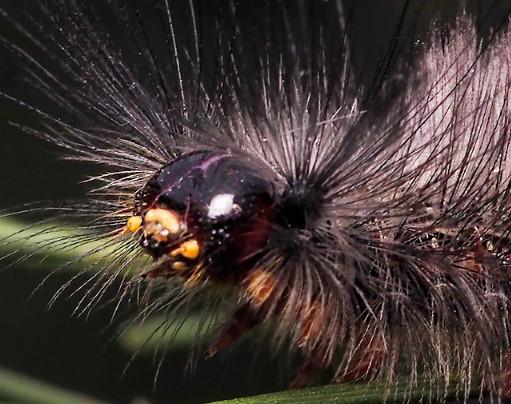
 young caterpillars ballooning (Photo: courtesy of Rudie Kuiter, Aquatic Photographics, Victoria) |
The hairs can cause skin irritation
(urticaria)
in people with sensitive skin.
The caterpillars have been found feeding on a variety of plants in suburban gardens including :
In plantation forests, they are a pest on :
In the wild they feed on plants such as:
Perhaps because the females are flightless, the newly hatched caterpillars have a special way of dispersing by spinning threads of silk which are caught in the wind ("ballooning").
The male caterpillars grow to a length of about 2 cms. |
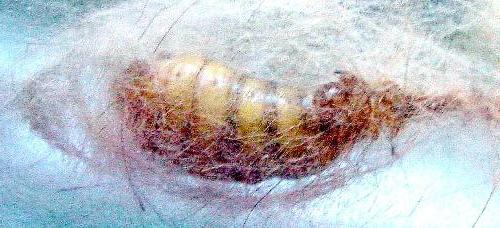
They pupate amongst the leaves of the foodplant in a sparse cocoon that they decorate with hairs from their larval skin, making these cocoons likely to cause urticaria too. The adults emerge after a few days.
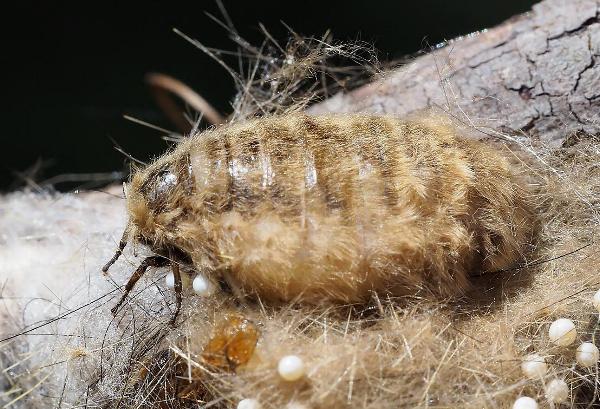
The female adult is dull brown with intersegmental fringes of pale hairs, and a band of pale hairs along each side. She is fat and flightless. She stays beside her cocoon emitting a pheromone to attract males. She has a length of about 1 cm.
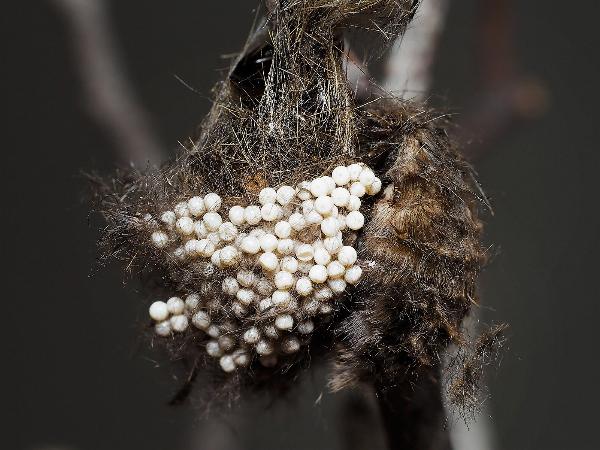
She lays eggs on and around her cocoon after fertilisation. The eggs are white and spherical.
The male has light and dark brown forewings with the various areas outlined in white. The hindwings are yellow with broad black margins. He has a wing span of about 2 cms.
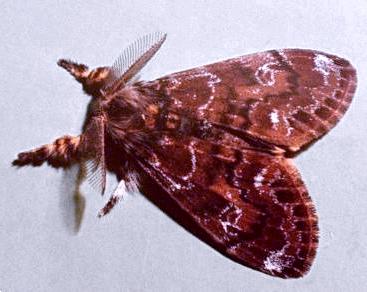
The male undersides are fawn with a vague dark diagonal mark under each wingtip..

The species is found over most of Australia, including
They seem to have ballooned their way across the Tasman Sea because the species has appeared in
So far this species has not spread beyond Australasia, although related and similar species occur in America.
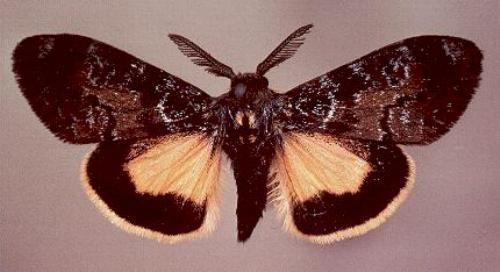
The sex pheromone components of this species has been determined by an international research team of Dr. Gerhard Gries (Simon Fraser Univ., Burnaby, B.C., Canada), Dr. John Clearwater (Clearwater Research & Consulting, Auckland, NZ) and Dr. Paul W. Schaefer (U.S. Dept. of Agric., Beneficial Insect Introd. Lab., Newark, USA). In December 2003, John Clearwater and Paul Schaefer completed the final field confirmation trapping in Campbelltown, NSW, using a completely synthetic lure, which proved to be very effective at attracting the males into traps. Therefore, there is now a powerful field sampling tool for population assessment, clarification of distribution or habitat preference, or behavior studies. This research was supported in part by Global Forest, an international research institute based in Banff, Alberta, Canada.
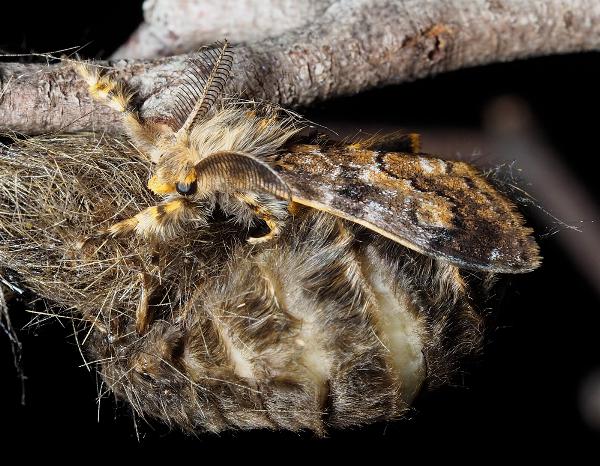
Control of the species is being attempted using:
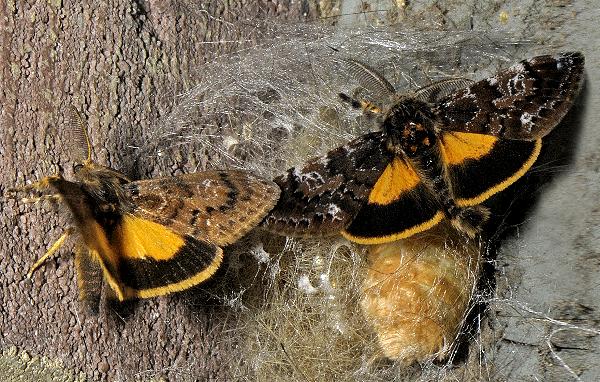
Further reading :
David Carter,
Butterflies and Moths,
Collins Eyewitness Handbooks, Sydney 1992, p. 271.
Ian F.B. Common,
Moths of Australia,
Melbourne University Press, 1990, pl. 18.9, pp. 70, 428.
Pat and Mike Coupar,
Flying Colours,
New South Wales University Press, Sydney 1992, p. 65.
Peter B. McQuillan, Jan A. Forrest, David Keane, & Roger Grund,
Caterpillars, moths, and their plants of Southern Australia,
Butterfly Conservation South Australia Inc., Adelaide (2019), pp. 148-149.
Peter Marriott,
Moths of Victoria: Part 2,
Tiger Moths and their Allies - Noctuoidea (A),
Entomological Society of Victoria, 2009, pp. 16-19.
Linda Rogan,
Painted Apple (or Acacia) Moth Teia anartoides,
Butterflies and Other Invertebrates Club,
Metamorphosis Australia,
Issue 58 (September 2010), pp. 14-18.
Francis Walker,
Catalogue of Lepidoptera Heterocera,
List of the Specimens of Lepidopterous Insects in the Collection of the British Museum,
Part 4 (1855), p. 804.
Paul Zborowski and Ted Edwards,
A Guide to Australian Moths,
CSIRO Publishing, 2007, p. 177.
 caterpillar |  butterflies |  Lepidoptera |  moths |  caterpillar |
(updated 29 January 2013, 22 October 2025)